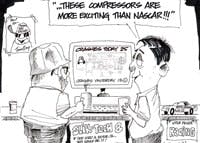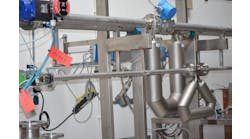By Greg McMillan and Stan Weiner, PE
Greg: My seven years in instrument design and construction that were spent in the field making control systems work provided a practical basis whose significance I appreciate more each year. Some of the more unusual stuff I learned is captured in the following Top Ten List.
Top Ten Things I Learned in the Field
10. Control valve stems and accessories must be able to support a 300-lb pipefitter.
9. Painters are more than willing and capable of sand-blasting your instruments.
8. Instruments need to be functionally tested during installation, checkout and startup.
7. Uncertain measurement and process technologies lead to uncertain startup schedules.
6. Installed measurement errors are often 10 times larger than catalog errors.
5. Don’t get stuck with automatic valves treated as piping unless you want stuck valves.
4. Sensors and valves are good at catching gloves, welding rods and wrenches.
3. Record freezing weather will occur before the steam tracing is turned on.
2. What is really in the sensing lines of a d/p cell is anybody’s guess.
1. Treat the pipe fitters, engineers, operators and technicians like family.
Stan: Did you decide to go to next big project construction site or take a dramatic turn in career by taking a job in Engineering Technology, known as ET, because people in that department seemed almost extraterrestrial.
Greg: The opportunity to join a department with 75 of the great minds in what was the third-largest chemical company was too good to pass up. I joined the modeling and control group. This department was the leader in developing computer programs for equipment specification, process design and dynamic simulation. The origin of leading physical property packages and process simulation software can be traced back to the brainiest of these engineers. I owe a lot of my understanding of process interactions and dynamics and their importance to leaders, such as Henry Chien and Vernon Trevathan, who excelled in the simulation of process and control systems and provided explanations of physical relationships that were clear, concise and insightful. Besides having access to the experts, I was given some of the more dynamically challenged applications.
Stan: What are some of the challengess of traveling in the fast lane of compressor speed and surge control?
Greg: The most dramatic application was a one-of-a-kind axial compressor that exhibited a runaway response where the speed would accelerate off-scale in matter of seconds when approaching the surge line. If a shutdown wasn’t immediate, the compressor would self-destruct. Since this compressor was the key to the nearly all the chemical intermediate and final product lines for textiles, and only one spare rotor existed, considerable energy was assigned to deal with the considerable energy gone amok.
I added an analog derivative module that detected the acceleration. Between this and the correction of the first-out sequence alarm, the automatic shutdown of the compressor was fast enough to prevent damage, and the causes of the trip were diagnosed. It became clear we needed a better surge prevention system. The suction flow sensor was across an elbow with a straight run pf less than one pipe diameter upstream and downstream. The vent valves were sloppy and unreliable. I replaced the suction sensor with an averaging pilot tube array upstream of the elbow and put in fast dual-vent valves for each stage with positioners that worked. The surge control system worked and on-stream time increased.
Stan: One the things I heard from operators is that compressors get into trouble too fast, and that it requires an operator to babysit the compressor and bring it online very slowly.
Greg: Operators are right in saying things happen too fast. A compressor can approach a surge curve in a matter of seconds because of the proximity to the surge curve and the installed characteristic of rotary valves used to trip downstream equipment, even though the stroking time of these trip valves is slowed down. There is a precipitous drop in flow at the start of a surge. In less than 0.05 seconds, there can be a flow reversal followed by a surge cycle every couple of seconds. However, this incredibly fast stuff is even more of a justification for automation. On several compressors, I used a special fast- scan DCS controller for automated ramping of suction valves, vanes and user valves, and surge prevention. The resulting compressor startups were orders of magnitude quicker and more reliable. Whenever I hear something can’t be done, to me it is an indication of a more interesting application and larger opportunity than impossibility.
Stan: How about some false starts?
Greg: I remember thinking I could make a feedback controller fast enough to prevent and recover from surge. Even after I had dealt correctly with the frequency response issues, employed sensor with a fast response time (e.g. 0.1 seconds), and added a tuned booster to make the valve fast (e.g. pre-stroke dead time less than ¼ of second and stroking time less than 2 seconds), the compressor could still get into surge, and the analog feedback controller could not stop the surge cycles.
I quickly became an advocate of a smooth transition between an open- loop backup and feedback control that opens the vent or recycle valves incrementally once the compressor gets too close to the surge curve. The open-loop backup can be readily added to a distributed control system module.
Greg: An open-loop backup is useful whenever an abrupt event catches the loop off guard. The classic case is compressor anti-surge control, but another application is an exothermic reactor control where, during the approach to a higher reaction temperature and rate (lower batch time), a higher than expected raw material concentration or catalyst activity triggers a runaway acceleration. Less dramatic, but still problematic is the case when, during an approach to a lower pH setpoint in a static mixer (lower base reagent use), a strong acid upset from a batch operation or level switch-controlled sump causes a low RCRA pH violation within seconds.
A much slower reaction, but still an important case is that of a bioreactor when, during the approach to a lower substrate (e.g. glucose) concentration with less substrate inhibition (greater yield), non-ideal mixing and a drop in substrate feed triggers food-starved biomass to eat its own product (yuck).
To reiterate, an open-loop backup is useful in the following situations: 1) for compressor anti-surge control, 2) exothermic reactor temperature control, 3) static mixer RCRA pH control and 4) bioreactor substrate concentration control.
In each of these cases, there is a significant undesirable event that requires a slow approach and fast recovery. The first three cases involve environmental and property protection. The last thing you want is to test the adequacy of your interlock systems or have a recordable event.
Final Note From Stan: Please send us your own compressor stories.
When should you not use a valve positioner?
Send an e-mail with your answer to the Puzzler, CONTROL questions, or comments to [email protected].







